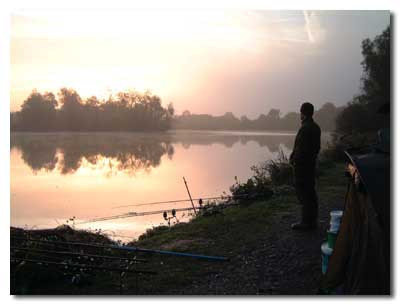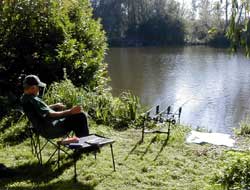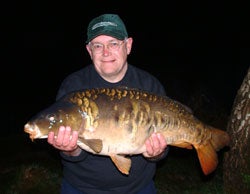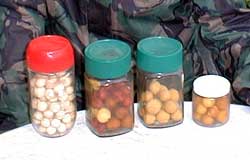It seems a shame, in a way, that carp anglers have been so clever and innovative over the past 50 years that the scene has arrived at a point where it could possibly be in danger of stagnating because it is known, beyond much doubt, what tackle, baits and approach are best to catch carp on the vast majority of waters. It is only very slight variations on a standard theme that are left to choice. But let’s have a reality check before I go on: right now carp fishing is still increasing in popularity faster than any other branch of the sport. Big carp can be found in waters all over the UK. No one is far from a good carp water. Add to that the fact that carp grow to heavy weights and reward the captor with an excellent fight and you begin to understand why they are so popular. Perhaps the one thing that remains within the scope of water craft is choice of swim, but even that is standardised on many waters, for there are undisputed hot-spots that almost inevitably produce fish to a competent ‘rod’ given the right conditions. Even on vast waters like Chantecoq in France, and taking into account that you can’t fish in all areas, there are certain swims that are far more likely than any other to produce fish, in all kinds of conditions. Yet there are waters where it pays to choose a swim with a degree of sound judgement, where there are no particular swims that are hot-spots at all times. Take a walk before wetting a line On most of the carp waters I fish I make a point of walking round the water before I decide where to fish. I look for carp clouding the water or bubbling, or giving their presence away in some form or other. This is then related to current wind direction, and where the wind is going to be later in the day; where the sun hits the water at that time, and then later; approximate water temperature and depth of water; presence of weed, or not, etc, etc.
Some things hardly ever change I’m always a bit sad when I arrive at the time when the intense learning comes to an end (we never stop learning something, but it does slow down) for it won’t be quite as enjoyable. Most waters don’t change much over the years and there will come a time when I’ll know where to fish and what to do without thinking about it too much. For instance, one carp water I used to fish over 20 years past, which I fished again as a guest about five years ago, hadn’t changed a bit as far as the approach to fishing it was concerned. I knew from all that time ago that in a certain swim you had to cast to within 6ins of the lily pads on the far bank to get the maximum runs per session. That isn’t to say you couldn’t get a run at all if you fished well away from the pads, but that the difference was usually quite remarkable. The syndicate member I was with knew that you had to cast close to the pads, but I don’t think he knew exactly just how close you had to be. A foot was too far away, where 6ins was not too close. The pads grew to the edge of a shelf, and the carp patrolled and fed along the edge of this shelf in what they must have thought was a safe area, hence the reason they were so willing to accept baits in that area but not so often in the open water, which they visited often enough, for you could see the tracks and patches of bubbles coming from the shelf. What you had to do was ensure that when you got a run you hit it immediately (no wandering away from the rods) and held the fish tight so that they couldn’t enter that labyrinth of stalks which grew as thick as a man’s arm. You hooked and held and gave no quarter and more often than not the carp would eventually give and you could pull it into open water. Not quite as difficult as it sounds because the fish had no room to get up enough acceleration to charge into the pads.
That was the pattern for most of the day, apart from towards the end of the session when the member decided there was a difference in how we were fishing. It may have been only 6ins or so, but that was enough, for I’d had six good doubles to over 19lb and he’d had none. The moment he ensured his baits lay within 6ins of the pads he caught a fish before we had to pack for home. So, knowledge I had gleaned a good many years ago was still valid today, and that is the case on most waters and with all species. Only drastic changes in the topography of the water, brought about by drought and encroaching weedbeds in the main, can make much of a difference. Plus, of course, if the carp stock levels had changed, which in this case they hadn’t. Baits and flavours Boilies, or boilie ingredients and flavours to be more precise, have always been a contentious issue. I constantly waver between a) Thinking the whole bait ingredient issue is more to do with catching anglers than it is about catching fish, with carp anglers at the front of the queue, and b) That they do make a great deal of difference. I think I have settled for somewhere between the two extremes. Ingredients and flavours do make a difference, I have no doubt whatsoever, but it is to what extent that is open to conjecture. Some of the rubbish you hear and read about makes you want to puke. And the descriptions on some bait containers rival even the wildest prose of the most imaginative estate agent. To read some bait blurbs you would think that all you had to do to catch a big carp was turn up at any water that holds big carp with your tackle and a bag of that particular bait. The following story puts things into perspective.
And that isn’t a knock at carp anglers, after all, they have been the most innovative fishermen in the last 50 years. No magic ingredients, but… Good bait does make a difference, for there are too many instances of a few carp anglers catching far more fish than most others when they are obviously not otherwise doing anything different. They haven’t acquired a magic ingredient, they’ve simply found a bait that the carp are very attracted to in all the right departments, ie, smell, taste, colour, and, probably most important of all, uniqueness and are presenting it in the right place to good effect. As with ourselves, I assume, some of the tastes that carp are attracted to are acquired tastes, in that some of the baits we try may not be too appealing to the carp the first few times we introduce them to a water. This is often a good thing, for those baits that take a little longer to establish usually last that much longer before the carp decide they’ve had enough. The best way of establishing a new bait is to throw in plenty of it, not in huge piles at odd times, but in lots of smaller doses, scattered over many areas of the lake, as often as you possibly can.
The thinking angler will always do best Yet no matter how sophisticated carp angling tackle and bait becomes it is still the thinking angler, the one who has decent water craft, who will catch more fish than anyone else. When carp fishing moves into the next millennium and electronic gadgetry rules, the basic principles of fishing (find the fish, and offer them a well presented, attractive bait) will still apply. |
Welcome!Log into your account















